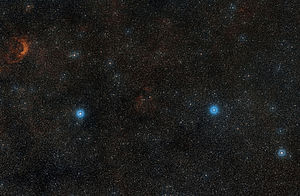 HD 87643 is embedded in the faint nebulosity at the centre of this image. The red arc is NGC 3199, a Wolf–Rayet nebula around WR 18. | |
| Observation data Epoch J2000 Equinox J2000 | |
|---|---|
| Constellation | Carina |
| Right ascension | 10h 04m 30.2840s [1] |
| Declination | −58° 39′ 52.091″ [1] |
| Apparent magnitude (V) | 8.87 [2] (7.4 - 9.8 [3]) |
| Characteristics | |
| Spectral type | B3 I[e] [4] |
| U−B color index | −0.54 [2] |
| B−V color index | +0.69 [2] |
| Variable type | INA [3] |
| Astrometry | |
| Proper motion (μ) |
RA: −7.557
[1]
mas/
yr Dec.: +5.438 [1] mas/ yr |
| Parallax (π) | 0.6293 ± 0.1227 mas [1] |
| Distance | approx. 5,000
ly (approx. 1,600 pc) |
| Absolute magnitude (MV) | −4.1 [5] |
| Details | |
| Mass | 25 [6] M☉ |
| Luminosity | 41,000 [7] L☉ |
| Temperature | 17,000 [7] K |
| Other designations | |
| Database references | |
| SIMBAD | data |

HD 87643 is a B[e] class binary star embedded in a reflection nebula.
The system is described as having "one of the most extreme infrared excesses for this object class". It harbours a large amount of both hot and cold dust, and is surrounded by a debris disk with radius 2.5-3 AU [6] and an extended reflection nebula. and is important for astronomers in their study of stellar formation. [8]

All the properties of HD 87643 are highly uncertain. Its distance has been estimated anywhere from one to six kpc. The General Catalogue of Variable Stars classifies it as an Orion variable, a pre-main sequence star, but other authors consider it to be a supergiant B[e] star. It has been confirmed to be a binary star system with the two stars separated by about 52 AU, but the nature of the companion is unknown. [8]
References
- ^ a b c d e Vallenari, A.; et al. (Gaia collaboration) (2023). "Gaia Data Release 3. Summary of the content and survey properties". Astronomy and Astrophysics. 674: A1. arXiv: 2208.00211. Bibcode: 2023A&A...674A...1G. doi: 10.1051/0004-6361/202243940. S2CID 244398875. Gaia DR3 record for this source at VizieR.
- ^ a b c McGregor, P. J.; Hyland, A. R.; Hillier, D. J. (1988). "Atomic and molecular line emission from early-type high-luminosity stars". Astrophysical Journal. 324: 1071. Bibcode: 1988ApJ...324.1071M. doi: 10.1086/165964.
- ^ a b Samus, N. N.; Durlevich, O. V.; et al. (2009). "VizieR Online Data Catalog: General Catalogue of Variable Stars (Samus+ 2007-2013)". VizieR On-line Data Catalog: B/GCVS. Originally Published in: 2009yCat....102025S. 1. Bibcode: 2009yCat....102025S.
- ^ Skiff, B. A. (2014). "VizieR Online Data Catalog: Catalogue of Stellar Spectral Classifications (Skiff, 2009-2016)". VizieR On-line Data Catalog: B/Mk. Originally Published in: Lowell Observatory (October 2014). 1. Bibcode: 2014yCat....1.2023S.
- ^ Surdej, A.; Surdej, J.; Swings, J. P.; Wamsteker, W. (1981). "The Reflection Nebula Surrounding HD87643". Astronomy and Astrophysics. 93: 285. Bibcode: 1981A&A....93..285S.
- ^ a b Altvater, Michael A.; Wu, Shuang; Zhang, Zhenyuan; Zhu, Tianhui; Li, Guohong; Watanabe, Kenji; Taniguchi, Takashi; Andrei, Eva Y. (2019). "Electrostatic imaging of encapsulated graphene". 2D Materials. 6 (4): 045034. arXiv: 1911.04114. Bibcode: 2019TDM.....6d5034A. doi: 10.1088/2053-1583/ab254e. S2CID 189991060.
- ^ a b Millour, F.; Chesneau, O.; Borges Fernandes, M.; Meilland, A.; Mars, G.; Benoist, C.; Thiébaut, E.; Stee, P.; Hofmann, K.-H.; Baron, F.; Young, J.; Bendjoya, P.; Carciofi, A.; Domiciano De Souza, A.; Driebe, T.; Jankov, S.; Kervella, P.; Petrov, R. G.; Robbe-Dubois, S.; Vakili, F.; Waters, L. B. F. M.; Weigelt, G. (2009). "A binary engine fuelling HD 87643's complex circumstellar environment. Determined using AMBER/VLTI imaging". Astronomy and Astrophysics. 507 (1): 317–326. arXiv: 0908.0227. Bibcode: 2009A&A...507..317M. doi: 10.1051/0004-6361/200811592. S2CID 16463437.